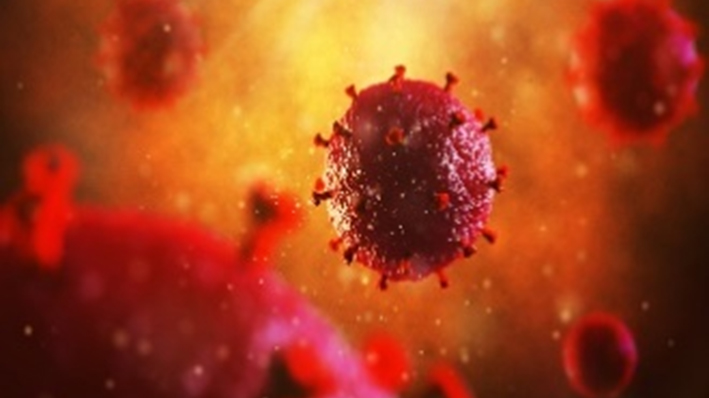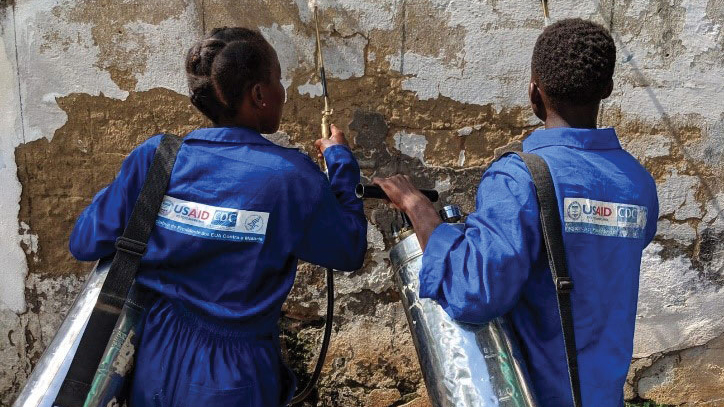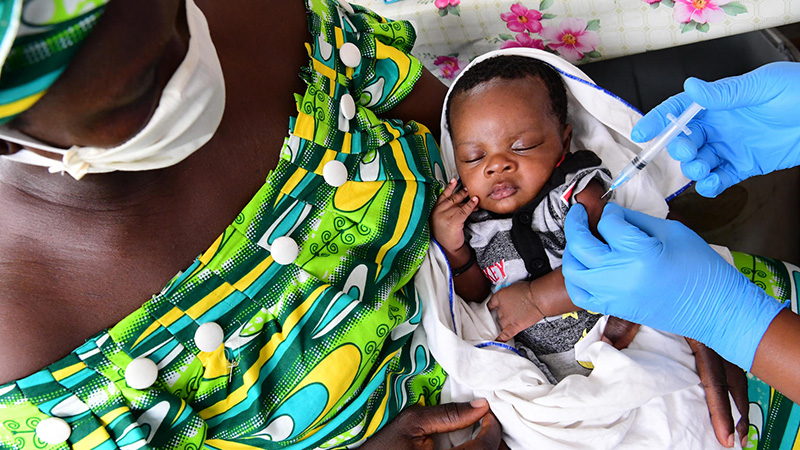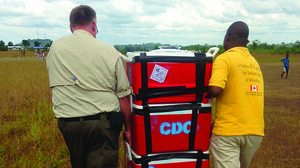The Center for Global Health Programs Adapt to Provide Lifesaving Services During COVID-19
A pandemic can disrupt years of progress and set back prevention and control of diseases. The COVID-19 pandemic presents multiple challenges, especially for countries with fragile health systems already working to address epidemics like HIV, malaria, measles, and other vaccine-preventable diseases. COVID-19 mitigation measures such as physical distancing and enhanced sanitation create challenges for delivery of lifesaving prevention and treatment programs as do additional pressures on health systems caused by COVID-19. The Center for Global Health’s programs are partnering with host countries’ ministries of health, U.S. government agencies, and other partners both in responding to COVID-19 and in adapting interventions for malaria, HIV, neglected tropical diseases, and vaccine-preventable diseases.

Workforce Development: More than 17,900 people have received laboratory training from CGH’s Division of Global Health Protection since 2006.

Response to Outbreaks: In 2019, FETP had 1,405 graduates in total across Frontline, Intermediate, and Advanced programs, with a subset of residents responding to over 450 suspected outbreaks.

Provide Antiretroviral Treatment (ART): By the end of 2019, 10.5 million people were on ART as a result of CDC’s support of HIV care and treatment, through the President’s Emergency Plan for AIDS Response.

Conducting Population-Based Household Surveys: 15 countries have completed these surveys since 2015. These CDC designed and implemented HIV surveys measured reductions in new infections, high rates of viral load suppression, and identified sub-populations yet to be fully reached, all integral in achieving epidemic control.

Eliminating Parasitic Diseases: Scale up of proven interventions has led to:
- 315 million people no longer requiring treatment for lymphatic filariasis
- 3.5 million people no longer at risk for Guinea worm disease
- 150 million people no longer requiring treatment for trachoma

Reducing Malaria Deaths: CDC and global partners have helped save more than seven million lives and prevented more than one billion cases of malaria since 2000.

Eradicating Polio: Polio cases have dropped more than 99% since 1988. In August 2020, the African Continent was certified free of wild polio virus. Afghanistan and Pakistan are the only countries that have not interrupted wild poliovirus transmission. More than 90% of the world is free from wild poliovirus.

Measles and Rubella Elimination: Since the launch of the Measles & Rubella Initiative (M&RI) and during the period 2000-2019, more than 25.5 million measles deaths have been prevented through vaccination and measles deaths by 62% in that period.
HIV remains a leading cause of death in many countries and is the leading cause of mortality among women of reproductive age. Tuberculosis (TB) is the leading infectious disease killer globally. CDC is at the forefront of the HIV and TB fights, tackling these epidemics in more than 45 countries and regions around the world. CDC ensures that data and science lead to effective public health practice for the most efficient, high impact results. As an implementer of the President’s Emergency Plan for AIDS Relief (PEPFAR), CDC works with countries to build sustainable national programs and public health systems that can respond effectively to their HIV and TB epidemics. Working in Africa, Asia, Central America, and the Caribbean, the global HIV program’s foundational investments—including expertise in epidemiology, surveillance, contact tracing and laboratory—continue to be key assets for addressing global health threats like TB, Ebola, and COVID-19.
By 2025, researchers predict that COVID-19 could trigger as much as a ten percent increase in HIV deaths and a 20 percent increase in TB deaths for many countries with which CDC partners.* These increases are closely linked to interruption in HIV treatment and decreases in TB diagnosis and treatment caused by the pandemic. To forestall this, CDC’s PEPFAR country teams are working with partners to expand differentiated service delivery models. These models increase access to lifesaving antiretroviral treatment through multi-month medication dispensing, community-based delivery options, and increasing clinic hours. CDC teams across the globe are working to ensure continued access to treatment while reducing the opportunity for exposure to COVID-19.
For example, in Thailand, CDC works with national and local partners to ensure people living with HIV continue to have safe access to care and treatment. There, teams are sending antiretroviral treatment by Thailand Post, the local postal service. Additionally, partners are providing online healthcare worker trainings on antiretroviral treatment, supply management, and care for people living with HIV during the COVID-19 pandemic. In South Africa, Nigeria, Zambia, Zimbabwe, Uganda, and other African countries, teams are delivering lifesaving medications directly to patients’ homes or to close community distribution points. Teams across the continent are also offering facility-led community-based testing, medication refill services, and other clinical services.

Drug-resistant Mycobacterium tuberculosis, CDC

Human Immunodeficiency Virus, CDC
Global Health in Action: To decrease morbidity and mortality among persons living with HIV, PEPFAR is committed to providing TB preventive treatment to all eligible people receiving antiretroviral treatment by 2021. In 2019, 1,532,141 people on antiretroviral treatment completed CDC/PEPFAR-supported TB preventive treatment, significantly reducing their chances of acquiring TB.
As with HIV, approaches that were developed to combat tuberculosis are now being used in the fight against COVID-19. The public health platforms built by CDC and health partners—as well as the innovative approaches to TB surveillance, treatment, prevention, and infection control—have improved multiple national and global health care systems. By encouraging robust implementation of infection prevention and control measures, CDC and partners work to ensure TB services continue to be deemed essential. These measures are critical to ensure the safety of health care workers and patients accessing care at health facilities. CDC works with partners to ensure that TB health facilities implement respiratory infection control measures for COVID-19. Such measures include triage, early identification, and separation of symptomatic patients; fast-tracking service; implementation of droplet and contact precautions; frequent handwashing; environmental engineering controls; and use of personal protective equipment.
Namibia has one of the highest TB infection rates in the world. In 2018, an estimated 13,000 people in Namibia fell ill with TB; more than 5,000 were undiagnosed. CDC is working with Namibia’s Ministry of Health and Social Services to ensure TB patients continue to receive care during the COVID-19 pandemic. Community health workers are now providing more TB services to patients where they live, reducing the number of clinic visits, thereby reducing patients’ chance of exposure to COVID-19 at healthcare facilities. Before COVID-19, the Ministry was already scaling up community services. Since the pandemic began, the Ministry has intensified roll out of these services. Community healthcare services are more convenient for patients who need medicine refills and other simple support services.
* https://www.thelancet.com/journals/langlo/article/PIIS2214-109X(20)30288-6/fulltext

Social distancing in the waiting area at Nyasho clinic, Mara region, Tanzania, 2020.
Credit: Amref Health Africa Tanzania
CDC is a global leader in malaria and parasitic diseases research and technical innovation to effectively control and eliminate these deadly diseases. CDC’s laboratories in Atlanta, including the insectary and parasitic diseases laboratories, provide critical support required to achieve these priorities.
CDC’s malaria program works to understand how to safely deliver malaria control interventions such as insecticide-treated bed nets, indoor residual spraying, and rapid diagnostic tests in the context of the COVID-19 response. Part of this work is done through the U.S. President’s Malaria Initiative. CDC assisted in developing WHO’s guidance for tailoring malaria interventions in the COVID-19 response. CDC has also provided specific technical guidance to maintain essential services for malaria in low-resource countries, and to inform the global malaria community on provision of safe and accessible malaria care and tools in the most affected countries.

President's Malaria Initiative supported Indoor Residual Spraying after Cyclone Idai, Mozambique, 2019.
Credit: Joy Peters, Department of State
CDC’s neglected tropical disease (NTD) program works with global partners to continue critical work to control, eliminate, and eradicate NTDs despite the COVID-19 pandemic. CDC works with partners to restart and monitor NTD programs safely. CDC continues to provide programmatic support to American Samoa for the elimination of lymphatic filariasis, making use of pre-recorded sessions and live virtual trainings with health workers to ensure quality implementation of this program.
CDC experts also work on validating SARS-CoV-2 antigens on the multiplex serological platform for integrated surveillance of NTDs, malaria, enteric diseases, and vaccine preventable diseases.
In August 2020, in collaboration with international partners, scientists from the Center for Global Health authored a paper calling attention to the potential impact of co-infection with malaria or NTDs and COVID-19. They also provided technical input into WHO’s recommendations for safely conducting NTD activities in COVID-19-affected settings. These recommendations describe the importance of close coordination between NTDs and COVID-19 programs during activity planning, modification of strategies to ensure COVID-19 precautions, protocols for protecting health workers, and mitigation measures for targeted communities.
Global Health in Action: Typically, about 2,000 cases of malaria are still reported in the United States each year, almost all among travelers returning from malaria endemic areas. CDC distributes otherwise unavailable, life-saving treatment for many of these cases.
Strong immunization programs in the United States have reduced domestic disease burden and are critical to keep Americans safe and healthy. However, Americans remain at risk from imported vaccine-preventable diseases, such as measles. The Center for Global Health (CGH) is the U.S. government scientific lead in the global effort to eradicate polio. CDC’s global immunization activities focus on reaching children in developing countries who are at the highest risk for illness and death from vaccine-preventable diseases. These interventions also help prevent these diseases from reaching U.S. borders.
In the midst of the COVID-19 pandemic, CDC’s global immunization program worked with partners to develop infection prevention and control guidance for vaccinators to safely undertake immunization work in the COVID-19 environment. Ethiopia used these guidelines to inform their June/July 2020 measles vaccination campaign. The campaign mobilized an additional 6,300 health workers to minimize crowding and increase physical distancing at vaccination posts. Ethiopia also extended the vaccine campaign for three additional days to decrease crowd size and masks and hand sanitizer were provided to all campaign support staff. The result was >95% campaign coverage and more than 14 million children vaccinated. Lessons learned from the implementation of measles campaigns, as well as ongoing campaigns for polio and other vaccines during a pandemic, will help inform the rollout of COVID-19 vaccines across the globe.

A child receives polio drops during a vaccination campaign in Katsina State, Nigeria, 2014.
Credit: CDC STOP Program, A.J. Williams
In order to re-start vaccination campaigns, CDC provided technical advice to the Global Polio Eradication Initiative, the Global Measles Outbreak Strategic Response, and the maternal and neonatal tetanus elimination work plans. CDC collaborated with ministries of health to develop a framework for the resumption of immunization activities. For example, before COVID-19, CDC had surged personnel into countries with outbreaks of type 2 circulating vaccine-derived poliovirus (cVDPV) to help them respond with high quality vaccine rounds. CGH has since been working with countries to restart vaccination in a COVID-19 environment safely where possible. CGH is also helping plan for the introduction of oral polio vaccine (nOPV2) to help stem current outbreaks of vaccine-derived polio and avoid future ones.
CGH is supporting global COVID-19 vaccine implementation planning by working with countries to strengthen national immunization advisory groups, develop vaccine introduction and communication protocols that engage stakeholders and communities, and create monitoring and evaluation plans for COVID-19 vaccine implementation. CDC is also providing technical assistance to 30 low-and middle-income countries to strengthen readiness to implement and monitor COVID-19 vaccines when they become available. These and other activities are focused on reducing the COVID-19 disease burden, enhancing global health security, and strengthening capacity to vaccinate in response to future epidemic and pandemic threats.
Global Health in Action: In 2019, CDC supported 43 countries with the introduction of vaccines, including hepatitis B, inactivated polio vaccine, rubella, and rotavirus.
More than 148 million people in 36 countries – mostly children and babies – are at risk for missing measles vaccinations due to delays or suspensions of planned measles vaccination campaigns in 2020.
Despite having a safe and effective vaccine for more than 50 years, measles cases surged worldwide in 2018 and 2019, claiming hundreds of thousands of lives, which could have been prevented. On top of this resurgence, the unprecedented COVID-19 pandemic has further slowed efforts to bring the global measles epidemic under control. More than 148 million people in 36 countries – mostly children and babies – are at risk for missing measles vaccinations due to delays or suspensions of planned measles vaccination campaigns in 2020. Several of these countries were already experiencing national or geographically specific measles outbreaks.
In response to the global increase in measles outbreaks, the Center for Global Health activated the Measles Incident Management System in February 2020.
This activation allows CDC to:
- Leverage existing and new assets to provide technical support and direction for priority countries.
- Investigate and respond to outbreaks (currently from Atlanta).
- Enhance efforts to detect and prevent outbreaks from occurring in high-risk areas.
Pandemic-driven vaccination disruptions could reverse hard-earned progress around the globe, causing a devastating impact on child health and mortality. Vaccine-preventable diseases have not disappeared during this pandemic, and infants and children who are not protected by vaccines remain vulnerable to measles and other potentially deadly diseases.

A baby is weighed and vaccinated in the health center of Gonzagueville, a suburb of Abidjan, in the Côte d'Ivoire. His mother and the nurses wear masks and gloves to protect against the COVID-19, 2020.
Credit: UNICEF
Over 29,000 polio staff and contractors worldwide have participated in the COVID-19 response.
Due to the COVID-19 pandemic, partners in the Global Polio Eradication Initiative recommended countries temporarily pause house-to-house polio vaccination campaigns and made the polio program’s workers and resources available to fight COVID-19. While restoring polio surveillance, CDC has continued to work with countries to use its polio surveillance and response networks to conduct COVID-19 case detection, contact tracing, laboratory testing, and data management. Polio data management systems and front-line staff in many countries are accelerating COVID-19 detection and response. Over 29,000 polio staff and contractors worldwide have participated in the COVID-19 response.
In August 2020, CDC joined international partners in recognizing the certification of the African Region as wild poliovirus free. This milestone marks a huge step forward on the road to global polio eradication. Now, over 90% of the world’s population is certified free of wild poliovirus. CDC has been committed to eradicating polio in Africa since 1993 when the agency supported the first efforts to establish a viable polio eradication program. To protect global progress against polio, countries around the world must maintain high population immunity to mitigate importation of polioviruses from the two remaining endemic countries, Pakistan and Afghanistan. Countries must also quickly stop outbreaks of circulating vaccine-derived poliovirus, wherever they occur. In Pakistan and Afghanistan, CDC is providing technical guidance on resumption of services, revised immunization activity scheduling, geographical prioritization, and operational and communication adjustments.

Mike Staley (CDC) and Alie Brima Tia (Sierra Leone Ministry of Health), transporting Ebola specimens from a UN helicopter, to the CDC Bo Lab in Sierra Leone, 2015.
Credit: Tara Sealy
Global Health in Action: CDC, a founding member of the Global Polio Eradication Initiative partnership, has helped prevent more than 18 million children from being paralyzed by polio through vaccination with the cooperation of 200 countries.